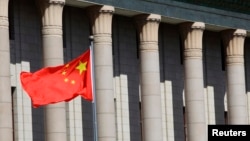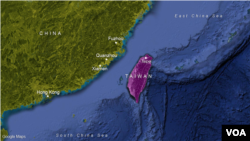Taiwan accused China of using Sao Tome and Principe's financial woes to push its "one China" policy after the small West African state ended ties with the self-ruled island, with Taipei saying the move would not help relations across the Taiwan Strait.
China's claims to Taiwan have shot back into the spotlight since U.S. President-elect Donald Trump broke diplomatic protocol and spoke with Taiwan President Tsai Ing-wen earlier this month, angering Beijing.
Trump has also questioned the "one China" policy which the United States has followed since assuming relations with Beijing in 1979, under which Washington acknowledges China's position that Taiwan is part of China.
The election of Tsai from the pro-independence Democratic Progressive Party earlier this year infuriated Beijing, which suspects she wants to push for the island's formal independence, though she says she wants to maintain peace with China.
Taiwan Foreign Minister David Lee said Taipei would not engage in "dollar diplomacy" after Sao Tome's decision.
"We think the Beijing government should not use Sao Tome's financing black hole ... as an opportunity to push its 'one China' principle," Lee told a news conference in Taipei on Wednesday. "This behavior is not helpful to a smooth cross-Strait relationship."
Taiwan's presidential office said China's use of Sao Tome's financial woes to push its "one China" policy would harm stability across the Taiwan Strait.
"This is absolutely not beneficial to the long-term development of cross-Strait relations," it said in a statement.
China welcomes move
In Beijing, China welcomed the move, without explicitly saying it had established formal relations with the former Portuguese colony or making any mention of a request for financial aid.
"We have noted the statement from the government of Sao Tome and Principe on the 20th to break so-called 'diplomatic' ties with Taiwan. China expresses appreciation of this, and welcomes Sao Tome back onto the correct path of the 'one China' principle," the ministry said in a statement.
China says Taiwan has no right to diplomatic recognition as it is part of China, and the issue is an extremely sensitive one for Beijing.
Defeated Nationalist forces fled to Taiwan at the end of a civil war in 1949 and Beijing has never renounced the use of force to bring Taiwan under its control.
'21 allies left'
In Africa, only Burkina Faso and Swaziland now maintain formal ties with Taiwan. President Tsai will visit Central American allies Honduras, Nicaragua, Guatemala and El Salvador next month.
"We now have 21 allies left. We must cherish them," Lee said.
China and Taiwan had for years tried to poach each other's allies, often dangling generous aid packages in front of developing nations.
But they began an unofficial diplomatic truce after signing a series of landmark trade and economic agreements in 2008 following the election of the China-friendly Ma Ying-jeou as Taiwan's president.
Sao Tome and Principe's tiny island economy is heavily dependent on cocoa exports but its position in the middle of the oil-rich Gulf of Guinea has raised interest in its potential as a possible future oil and gas producer.
Diplomatic sources in Beijing have previously said Sao Tome was likely high on China's list of countries to lure away from Taiwan.
In 2013, Sao Tome said China planned to open a trade mission to promote projects there, 16 years after it broke off relations over Sao Tome's diplomatic recognition of Taiwan.












